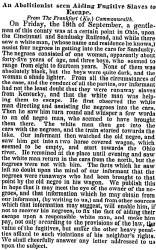Record Data
Source citation
“An Abolitionist Seen Aiding Fugitive Slaves to Escape,” New York Times, October 9, 1851, p. 2: 6.
Original source
Frankfort (KY) Commonwealth
Newspaper: Publication
New York Daily Times
Newspaper: Headline
An Abolitionist Seen Aiding Fugitive Slaves to Escape
Newspaper: Page(s)
2
Newspaper: Column
6
Type
Newspaper
Date Certainty
Exact
Transcriber
Michael Geduldig, Dickinson College
Transcription date
Transcription
The following text is presented here in complete form, as true to the original written document as possible. Spelling and other typographical errors have been preserved as in the original.
An Abolitionist seen Aiding Fugitive Slaves to Escape.
From the Frankfort (Ky.) Commonwealth.
From the Frankfort (Ky.) Commonwealth.
On Friday, the 18th of September, a gentlemen of this county was at a certain point in Ohio, upon the Cincinnati and Sandusky Railroad, and while there saw a white man, (whose name and residence he knows,) assist four negroes in getting into the cars for Sandusky. The negroes consisted of one woman, apparently about forty-five years of age, and three boys, who seemed to range in age from eight to fourteen years. None of them was absolutely black, but the boys were quite dark, and the woman a shade lighter. From all the circumstances of the case, and the conduct of all the parties, our informant had not the least doubt that they were runaway slaves from Kentucky, and that the white man was helping them to escape. He first observed the white man directing and assisting the negroes into the cars. Then he saw him turn round and whisper a few words to an old negro man, who seemed to have brought them there. The white man then got into the cars with the negroes, and the train started towards the lake. Our informant then watched the old negro, and saw him get into a two horse covered wagon, which seemed to be empty, and start towards the Ohio river. He remained at the place until evening and saw the white man return in the cars from the north, but the negroes were not with him. The facts which he saw left no doubt upon the mind of our informant that the negroes were runaways who had been brought to that point by the old negro in his wagon. We publish this in hope that it may meet the eye of the owner of the negroes, and that information which he may obtain from our informant, (by writing to us,) and from other sources which that information may suggest, will enable him, if not to recover his negroes, to fix the fact of aiding their escape upon a responsible white man, and make him pay, not only according to the provisions of the law, the value of the fugitives, but suffer the other heavy penalties affixed to such violations of his neighbor’s rights. We shall cheerfully answer any letter addressed to us upon this subject.


